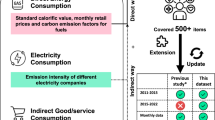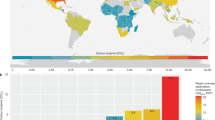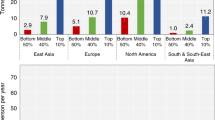Abstract
Populations in developed countries are ageing. However, the impact of senior citizens’ consumption on global carbon mitigation is poorly understood. Here we find that senior citizens have played a leading role in driving up GHG emissions in the past decade and are on the way to becoming the largest contributor. Considering the greenhouse gas footprint of household consumption across age groups in 32 developed countries, the senior contribution to national total consumption-based emissions increased from 25.2% to 32.7% between 2005 and 2015. Seniors in the United States and Australia have the highest per capita footprint, twice the Western average. The trend is mainly due to changes in expenditure patterns of seniors. The increasing carbon footprint of senior citizens will probably drive domestic production yet have limited effects on international carbon leakage. The demographic change poses more challenges in local mitigation and calls for deeper public mitigation efforts.
This is a preview of subscription content, access via your institution
Access options
Access Nature and 54 other Nature Portfolio journals
Get Nature+, our best-value online-access subscription
$29.99 / 30 days
cancel any time
Subscribe to this journal
Receive 12 print issues and online access
$209.00 per year
only $17.42 per issue
Buy this article
- Purchase on Springer Link
- Instant access to full article PDF
Prices may be subject to local taxes which are calculated during checkout




Similar content being viewed by others
Data availability
The EXIOBASE 3.7 data are available at: https://zenodo.org/record/3583071#.YPA5e0kzabg. Household expenditure by ageing groups is sourced from: EU Household Budget Survey (https://ec.europa.eu/eurostat/web/household-budget-surveys/database), US Consumer Expenditure Survey (https://www.bls.gov/cex/csxstnd.htm), Japan Family Income and Expenditure Survey (https://www.stat.go.jp/english/data/sousetai/1.html) and Household Expenditure Survey, Australia (https://www.abs.gov.au/statistics/economy/finance/household-expenditure-survey-australia-summary-results). The asset and liability data are sourced from Household Finance and Consumption Survey (https://www.ecb.europa.eu/stats/ecb_surveys/hfcs/html/index.en.html) for listed European countries, Office of National Statistics (https://www.ons.gov.uk/peoplepopulationandcommunity/personalandhouseholdfinances/incomeandwealth/adhocs/008570totalhouseholdwealthanditscomponentsbyagebandgreatbritainjuly2006tojune2016) for the United Kingdom, the Federal Reserve (https://www.federalreserve.gov/releases/z1/) for the United States, Family Income and Expenditure Survey (https://www.stat.go.jp/english/data/sousetai/1.html) for Japan and Household Budget Survey (https://www.abs.gov.au/statistics/economy/finance/household-expenditure-survey-australia-summary-results) for Australia.
Code availability
Code to calculate the carbon footprint and associated decomposition analysis is available at: https://github.com/HeranZheng/Aging-society-and-carbon-mitigation.
Change history
12 April 2022
A Correction to this paper has been published: https://doi.org/10.1038/s41558-022-01359-9
References
Götmark, F., Cafaro, P. & O’Sullivan, J. Aging human populations: good for us, good for the Earth. Trends Ecol. Evol. 33, 851–862 (2018).
World Population Prospects 2019 (United Nations, 2019).
Bongaarts, J. & O’Neill, B. C. Global warming policy: is population left out in the cold? Science 361, 650–652 (2018).
Bradshaw, C. J. A. & Brook, B. W. Human population reduction is not a quick fix for environmental problems. Proc. Natl Acad. Sci. USA 111, 16610–16615 (2014).
Wynes, S. & Nicholas, K. A. The climate mitigation gap: education and government recommendations miss the most effective individual actions. Environ. Res. Lett. 12, 074024 (2017).
O’Neill, B. C. et al. Global demographic trends and future carbon emissions. Proc. Natl Acad. Sci. USA 107, 17521–17526 (2010).
Dalton, M., O’Neill, B., Prskawetz, A., Jiang, L. & Pitkin, J. Population aging and future carbon emissions in the United States. Energy Econ. 30, 642–675 (2008).
Menz, T. & Welsch, H. Population aging and carbon emissions in OECD countries: accounting for life-cycle and cohort effects. Energy Econ. 34, 842–849 (2012).
Zhang, C. & Tan, Z. The relationships between population factors and China’s carbon emissions: does population aging matter? Renew. Sust. Energy Rev. 65, 1018–1025 (2016).
Fan, J., Zhou, L., Zhang, Y., Shao, S. & Ma, M. How does population aging affect household carbon emissions? Evidence from Chinese urban and rural areas. Energy Econ. 100, 105356 (2021).
Kronenberg, T. The impact of demographic change on energy use and greenhouse gas emissions in Germany. Ecol. Econ. 68, 2637–2645 (2009).
Shigetomi, Y., Nansai, K., Kagawa, S. & Tohno, S. Changes in the carbon footprint of Japanese households in an aging society. Environ. Sci. Technol. 48, 6069–6080 (2014).
Carvalho, T. S., Santiago, F. S. & Perobelli, F. S. Demographic change in Brazil and its impacts on CO2 emissions. Econ. Syst. Res. https://doi.org/10.1080/09535314.2020.1783210 (2020).
Estiri, H. & Zagheni, E. Age matters: ageing and household energy demand in the United States. Energy Res. Soc. Sci. 55, 62–70 (2019).
Long, Y. et al. Unequal age-based household emission and its monthly variation embodied in energy consumption—a cases study of Tokyo, Japan. Appl. Energy 247, 350–362 (2019).
Tourism Trends and Ageing (Eurostat, 2021).
Reher, D. & Requena, M. Living alone in later life: a global perspective. Popul. Dev. Rev. 44, 427–454 (2018).
Jack, T. & Ivanova, D. Small is beautiful? Stories of carbon footprints, socio-demographic trends and small households in Denmark. Energy Res. Soc. Sci. 78, 102130 (2021).
Wu, W. et al. Implications of declining household economies of scale on electricity consumption and sustainability in China. Ecol. Econ. 184, 106981 (2021).
Yavari, F., Khajehzadeh, I. & Vale, B. Design options for an ageing New Zealand population: a life cycle energy (LCE) analysis. Energy Build. 166, 1–22 (2018).
Geys, B., Heggedal, T.-R. & Sørensen, R. J. Popular support for environmental protection: a life-cycle perspective. Br. J. Polit. Sci. https://doi.org/10.1017/S0007123419000607 (2020).
Ballew, M. et al. Do Younger Generations Care More About Global Warming? (Yale Program on Climate Change Communication, 2019); https://climatecommunication.yale.edu/publications/do-younger-generations-care-more-about-global-warming/
Ottelin, J., Cetinay, H. & Behrens, P. Rebound effects may jeopardize the resource savings of circular consumption: evidence from household material footprints. Environ. Res. Lett. 15, 104044 (2020).
Ivanova, D. et al. Environmental impact assessment of household consumption. J. Ind. Ecol. 20, 526–536 (2016).
Oswald, Y., Owen, A. & Steinberger, J. K. Large inequality in international and intranational energy footprints between income groups and across consumption categories. Nat. Energy 5, 231–239 (2020).
Ivanova, D. & Wood, R. The unequal distribution of household carbon footprints in Europe and its link to sustainability. Glob. Sustain. 3, e18 (2020).
Moutinho, V., Moreira, A. C. & Silva, P. M. The driving forces of change in energy-related CO2 emissions in Eastern, Western, Northern and Southern Europe: the LMDI approach to decomposition analysis. Renew. Sust. Energy Rev. 50, 1485–1499 (2015).
Le Quéré, C. et al. Drivers of declining CO2 emissions in 18 developed economies. Nat. Clim. Change 9, 213–217 (2019).
Shigetomi, Y. et al. Driving forces underlying sub-national carbon dioxide emissions within the household sector and implications for the Paris Agreement targets in Japan. Appl. Energy 228, 2321–2332 (2018).
Jiang, Y., Long, Y., Liu, Q., Dowaki, K. & Ihara, T. Carbon emission quantification and decarbonization policy exploration for the household sector—evidence from 51 Japanese cities. Energy Policy 140, 111438 (2020).
Yu, B., Wei, Y. M., Kei, G. & Matsuoka, Y. Future scenarios for energy consumption and carbon emissions due to demographic transitions in Chinese households. Nat. Energy 3, 109–118 (2018).
Browning, C. J., Qiu, Z., Yang, H., Zhang, T. & Thomas, S. A. Food, eating, and happy aging: the perceptions of older Chinese people. Front. Public Health 7, 60–64 (2019).
O’Leary, F. et al. Older Australians are eating more protein: secondary analysis of the 1995 & 2011/12 national nutrition surveys. Eur. J. Clin. Nutr. 74, 588–597 (2020).
Hallström, E., Carlsson-Kanyama, A. & Börjesson, P. Environmental impact of dietary change: a systematic review. J. Clean. Prod. 91, 1–11 (2015).
Botinestean, C. et al. Optimization of textural and technological parameters using response surface methodology for the development of beef products for older consumers. J. Texture Stud. 51, 263–275 (2020).
Holman, B. W. B., Fowler, S. M. & Hopkins, D. L. Red meat (beef and sheep) products for an ageing population: a review. Int. J. Food Sci. Technol. 55, 919–934 (2020).
Mudryj, A. N., Yu, N. & Aukema, H. M. Nutritional and health benefits of pulses. Appl. Physiol. Nutr. Metab. 39, 1197–1204 (2014).
Yagita, Y. & Iwafune, Y. Residential energy use and energy-saving of older adults: a case from Japan, the fastest-aging country. Energy Res. Soc. Sci. 75, 102022 (2021).
Jorgenson, A., Schor, J. & Huang, X. Income inequality and carbon emissions in the United States: a state-level analysis, 1997–2012. Ecol. Econ. 134, 40–48 (2017).
Wiedenhofer, D. et al. Unequal household carbon footprints in China. Nat. Clim. Change 7, 75–80 (2017).
Jorgenson, A. K., Dietz, T. & Kelly, O. Inequality, poverty, and the carbon intensity of human well-being in the United States: a sex-specific analysis. Sustain. Sci. 13, 1167–1174 (2018).
Büchs, M. et al. Sick and stuck at home—how poor health increases electricity consumption and reduces opportunities for environmentally-friendly travel in the United Kingdom. Energy Res. Soc. Sci. 44, 250–259 (2018).
Housing America’s Older Adults 2018 (Harvard Joint Center for Housing Studies, 2018).
Samir, K. C. & Lutz, W. The human core of the Shared Socioeconomic Pathways: population scenarios by age, sex and level of education for all countries to 2100. Glob. Environ. Change 42, 181–192 (2017).
Ivanova, D. et al. Quantifying the potential for climate change mitigation of consumption options. Environ. Res. Lett. 15, 093001 (2020).
Jarzebski, M. P. et al. Ageing and population shrinking: implications for sustainability in the urban century. npj Urban Sustain. 1, 17 (2021).
Pensions at a Glance 2019 (OECD, 2019).
Krawchenko, T., Keefe, J., Manuel, P. & Rapaport, E. Coastal climate change, vulnerability and age friendly communities: linking planning for climate change to the age friendly communities agenda. J. Rural Stud. 44, 55–62 (2016).
Lenzen, M. & et al. The environmental footprint of health care: a global assessment. Lancet Planet. Health 4, E271–E279 (2020).
Willand, N. & Horne, R. ‘They are grinding us into the ground’—the lived experience of (in)energy justice amongst low-income older households. Appl. Energy 226, 61–70 (2018).
Holley-Moore, G. & Creighton, H. The Future of Transport in an Ageing Society (Age UK and ILC-UK, 2015).
Scheibl, F. et al. When frail older people relocate in very old age, who makes the decision? Innov. Aging 3, igz030 (2019).
Dantuma, E. Elderly Care and Housing Demand in the EU (ING Group, 2019).
Health at a Glance 2017 (OECD, 2017).
Preventing Ageing Unequally (OECD, 2017).
Fuchs, D. et al. Power: the missing element in sustainable consumption and absolute reductions research and action. J. Clean. Prod. 132, 298–307 (2016).
Mueller, M., Bourke, E. & Morgan, D. Assessing the Comparability of Long-Term Care Spending Estimates Under the Joint Health Accounts Questionnaire (OECD, 2020).
Damiani, G. et al. Patterns of long term care in 29 European countries: evidence from an exploratory study. BMC Health Serv. Res. 11, 316 (2011).
Hertwich, E. G. The life cycle environmental impacts of consumption. Econ. Syst. Res. 23, 27–47 (2011).
Dietzenbacher, E., Los, B., Stehrer, R., Timmer, M. & de Vries, G. The construction of world input–output tables in the WIOD project. Econ. Syst. Res. 25, 71–98 (2013).
Steen-Olsen, K. et al. Accounting for value added embodied in trade and consumption: an intercomparison of global multiregional input–output databases. Econ. Syst. Res. 28, 78–94 (2016).
Zheng, H. et al. Entropy-based Chinese city-level MRIO table framework. Econ. Syst. Res. https://doi.org/10.1080/09535314.2021.1932764 (2021).
Zheng, H. et al. Regional determinants of China’s consumption-based emissions in the economic transition. Environ. Res. Lett. 15, 074001 (2020).
Stadler, K. et al. EXIOBASE 3: developing a time series of detailed environmentally extended multi-regional input-output tables. J. Ind. Ecol. 22, 502–515 (2018).
Wood, R. et al. The structure, drivers and policy implications of the European carbon footprint. Clim. Policy 20, S39–S57 (2020).
Wood, R. et al. Global sustainability accounting—developing EXIOBASE for multi-regional footprint analysis. Sustainability 7, 138–163 (2015).
Miller, R. E. & Blair, P. D. Input–Output Analysis: Foundations and Extensions 2nd edn (Cambridge Univ. Press, 2009).
Steen-Olsen, K., Wood, R. & Hertwich, E. G. The carbon footprint of Norwegian household consumption 1999–2012. J. Ind. Ecol. 3, 582–592 (2016).
Chou, R.-C. & Brown, S. A comparison of the size of families of Roman Catholics and non-Catholics in Great Britain. Popul. Stud. 22, 51–60 (1968).
Adsera, A. Religion and changes in family-size norms in developed countries. Rev. Relig. Res. 47, 271–286 (2006).
Ang, B. W. Decomposition analysis for policymaking in energy: which is the preferred method? Energy Policy 32, 1131–1139 (2004).
Bernhard, H. The Ownership of Assets and the Role of Age: Age-Specific Household Balance Sheets for Euro Area Countries. 8. Vienna (agenta, 2015); https://epc2016.princeton.edu/papers/160172
Long, Y., Yoshida, Y. & Dong, L. Exploring the indirect household carbon emissions by source: analysis on 49 Japanese cities. J. Clean. Prod. 167, 571–581 (2017).
Koide, R. et al. Carbon footprints and consumer lifestyles: an analysis of lifestyle factors and gap analysis by consumer segment in Japan. Sustainability 11, 5983 (2019).
Shigetomi, Y., Kanemoto, K., Yamamoto, Y. & Kondo, Y. Quantifying the carbon footprint reduction potential of lifestyle choices in Japan. Environ. Res. Lett. 16, 64022 (2021).
Fremstad, A., Underwood, A. & Zahran, S. The environmental impact of sharing: household and urban economies in CO2 emissions. Ecol. Econ. 145, 137–147 (2018).
Ottelin, J., Heinonen, J., Nässén, J. & Junnila, S. Household carbon footprint patterns by the degree of urbanisation in Europe. Environ. Res. Lett. 14, 114016 (2019).
Heinonen, J., Jalas, M., Juntunen, J. K., Ala-Mantila, S. & Junnila, S. Situated lifestyles: II. The impacts of urban density, housing type and motorization on the greenhouse gas emissions of the middle-income consumers in Finland. Environ. Res. Lett. 8, 35050 (2013).
Atkinson, A. & Hayes, D. Consumption Patterns Among Older Consumers: Statistical Analysis (ILC-UK, 2010).
Acknowledgements
The research is funded by the National Natural Science Foundation of China (41921005, 72140001, 72173133, 71974141,72033005), the SHAPE project (Norwegian Research Council 300330), the Bymarka project (Norwegian Research Council 287690/F20), the Royal Society (IEC\NSFC\191520) and the Natural Environment Research Council (NE/V002414/1, 2021 GRIP02COP-AQ).
Author information
Authors and Affiliations
Contributions
H.Z., R.W. and K.F. designed the research. H.Z. led the study and drafted the manuscript with efforts from all other authors (Y.L., R.W., K.F., D.M., Z.Z., J.M., E.H. and D.G.). H.Z., Y.L. and Z.Z. collected the raw expenditure data. R.W. constructed the EXIOBASE model. H.Z. and Y.L. conducted the decomposition analysis.
Corresponding authors
Ethics declarations
Competing interests
The authors declare no competing interests.
Peer review
Peer review information
Nature Climate Change thanks Marta Baltruszewicz and the other, anonymous, reviewer(s) for their contribution to the peer review of this work.
Additional information
Publisher’s note Springer Nature remains neutral with regard to jurisdictional claims in published maps and institutional affiliations.
Extended data
Extended Data Fig. 1 The carbon footprint by age groups in absolute unit.
The carbon footprint by age groups for 5 grand categories of 32 developed countries, from 2005 to 2015.
Extended Data Fig. 2 Per capita expenditure in Hotel & Restaurant and Real Estate Service.
Per capita expenditure in Hotel & Restaurant and Real Estate Service for different age groups for 5 grand categories in 2015.
Supplementary information
Supplementary Information
Supplementary Figs. 1–6, Discussion and Tables 1–7.
Rights and permissions
About this article
Cite this article
Zheng, H., Long, Y., Wood, R. et al. Ageing society in developed countries challenges carbon mitigation. Nat. Clim. Chang. 12, 241–248 (2022). https://doi.org/10.1038/s41558-022-01302-y
Received:
Accepted:
Published:
Issue Date:
DOI: https://doi.org/10.1038/s41558-022-01302-y
This article is cited by
-
Burden of the global energy price crisis on households
Nature Energy (2023)
-
A blessing or a curse? Can digital economy development narrow carbon inequality in China?
Carbon Neutrality (2023)
-
Reducing environmental impacts through socioeconomic transitions: critical review and prospects
Frontiers of Environmental Science & Engineering (2023)
-
Impact of aging-related consumption trend on carbon emission efficiency in China: mediation effect model based on industrial structure adjustment
Environmental Science and Pollution Research (2023)
-
Ageing society risks emission cuts
Nature Climate Change (2022)



